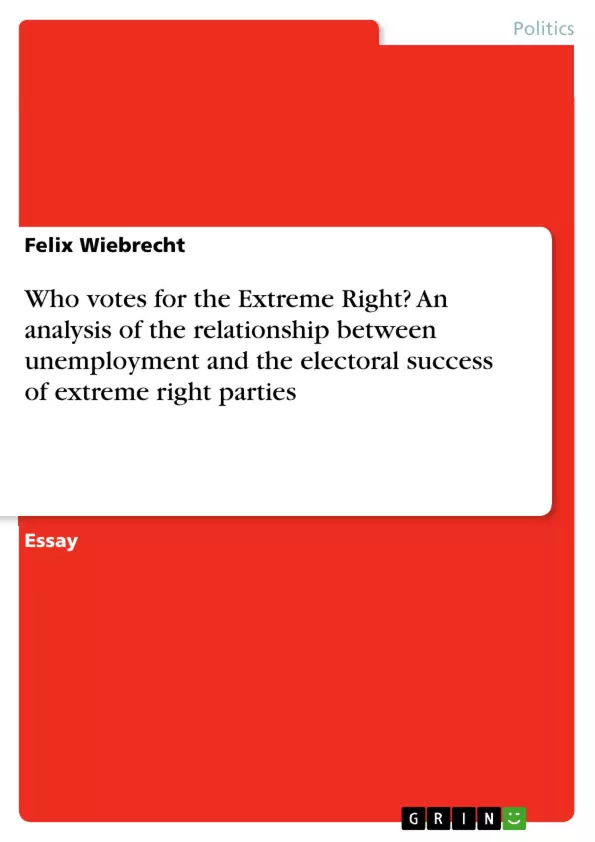A spectre is haunting Europe – the spectre of the new extreme right. Contrary to the communism, that Marx was referring to, the new extreme right seems to build up a broader societal base in Western Europe. In recent years the new extreme right (ER) parties have experienced an upsurge in popularity and electoral support. However, research on this group of parties could not establish a conclusive list of factors that are conducive for generating a high share of votes for the extreme right.
This essay attempts to assess one factor that might benefit the ER, namely unemployment. By following the assumptions of economic interest theory the author wants to investigate whether unemployment rates and the support for radical right parties stand in a relationship to each other and if so, in what kind of relationship. Thus, this essay will analyse the election results of the ER in German and Italy, both on the national and one regional level for each country and will examine whether they are related to the corresponding unemployment rates in the years 2000 to 2014. Lastly, the findings will then be assessed in a broader frame of existing literature.
Inhaltsverzeichnis (Table of Contents)
- Introduction
- Why Unemployment?
- Methodology
- Data discussion
- Discussion
- Conclusion
Zielsetzung und Themenschwerpunkte (Objectives and Key Themes)
This essay aims to analyze the relationship between unemployment rates and the electoral success of the extreme right in Germany and Italy. Based on the assumptions of economic interest theory, the author investigates whether unemployment rates and support for radical right parties are related and, if so, in what way.
- The emergence of the new extreme right in Western Europe and its rising popularity
- The impact of economic modernization and societal change on the rise of the extreme right
- The role of unemployment and the 'losers of modernity' in influencing support for the extreme right
- The economic interest theory and its application to understanding the appeal of extreme right parties to specific social groups
- The relationship between unemployment rates and the vote share of extreme right parties on both national and regional levels
Zusammenfassung der Kapitel (Chapter Summaries)
- Introduction: This chapter introduces the topic of the new extreme right in Western Europe and its recent rise in popularity. It highlights the lack of conclusive research on factors contributing to its electoral success and outlines the essay's objective to investigate the potential influence of unemployment.
- Why Unemployment?: This chapter examines the historical context of the relationship between unemployment and the rise of the extreme right. It introduces the work of Scheuch and Klingemann, who theorized the emergence of right-wing radicalism as a 'normal pathology' in rapidly changing societies. The chapter also discusses Betz's concept of 'losers of modernity' and their potential connection to voting for the extreme right.
- Methodology: This chapter details the methodology used in the essay, including the data sources and limitations. It outlines the choice of Germany and Italy as case studies due to their contrasting unemployment rates. Additionally, it addresses methodological challenges arising from differences in unemployment definitions between Germany and Eurostat.
Schlüsselwörter (Keywords)
This essay focuses on the relationship between unemployment and the electoral success of the extreme right, drawing on economic interest theory and the concept of 'losers of modernity'. Key themes include economic modernization, societal change, electoral behavior, and the impact of unemployment on support for radical right parties in Western Europe.
- Arbeit zitieren
- Felix Wiebrecht (Autor:in), 2015, Who votes for the Extreme Right? An analysis of the relationship between unemployment and the electoral success of extreme right parties, München, GRIN Verlag, https://www.grin.com/document/319109



